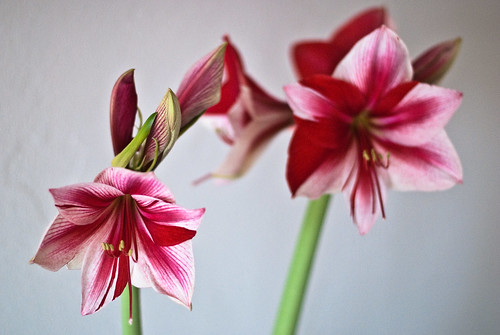Amaryllis are beautiful flowers that, if cared for correctly, will bloom year after year. They have a magnificent, exotic appearance and are best known for featuring red or red and white blooms. Although they do come in other colors such as purple, pink and yellow and some varieties are even multicolored. These colorful flowers are grown from bulbs and Amaryllis is the more popular name for what is actually the Hippeastrum bulb.
Amaryllis are easy to plant and of all the flowering bulbs, they are the easiest to bring to bloom. While they are ideal for any garden, they also make fantastic houseplants and have become popular gifts at Christmas because of this.
So, you have your Amaryllis bulb, now what do you do…?
Ideally you will plant it between October and January, they will then flower from winter to spring – generally within six weeks of planting. Amaryllis bulbs are tender and need warmth to grow therefore it is best to plant them in pots – in nutritious compost – and start them indoors, to avoid the frost. The Amaryllis should be grown in a pot only slightly bigger than the bulb itself, with two-thirds of the bulb remaining above the surface.
You should begin to water sparingly – then, as the new leaves develop, start watering regularly avoiding excessive watering while not letting the compost dry out.
Amaryllis should be placed in full sun – they will grow in light shade but they tend to develop better in brighter light – but remember to turn the pot regularly to avoid the stalk growing towards the light. You should feed your amaryllis bulb every few weeks with a balanced fertilizer and stake larger flowers as they start to grow.
Once the flowers on the initial stem have faded, cut the stem back to the bulb and another should grow and flower.
So, when can you move Amaryllis into the garden?
Firstly, as soon as the plant starts flowering it should be moved to a cooler spot to help extend the flowering period. Then, in the summer, once the last of the frost has passed, it can be moved outside. When choosing where to place it in the garden remember that Amaryllis should not be in intense sunlight, instead look for a semi-shaded position.
Once outside you need to be aware of and on the look out for slugs and snails! Similarly, if you find that your plant is flowering this could be down to growing in conditions that are too shady, or under-watering during the previous summer. But, this could also be due to attack from fungal disease or bulb pests.
You may be tempted to start pruning but you don’t need to do this until the leaves turn yellow (around late September) – then you can cut them back to around two inches from the top of the bulb. Your Amaryllis will need re-potting every two to three years in January to March – after flowering.
Amaryllis will be a great addition to any garden and if you care for them properly, you will be able to enjoy their pretty, colorful flowers for months and years to come.
The post How to Care for Amaryllis in Your Garden appeared first on The Lovely Plants.


















